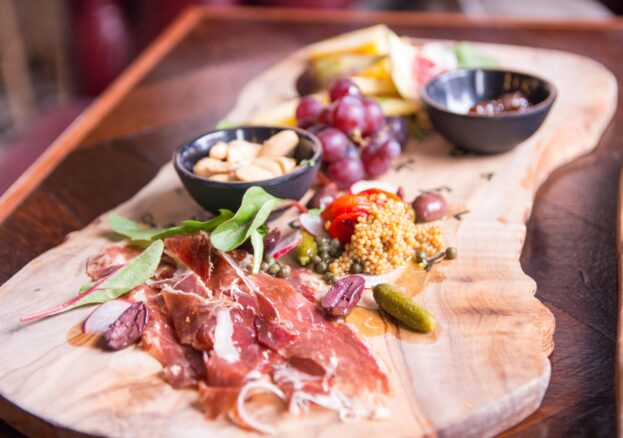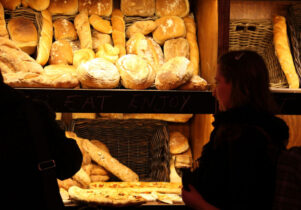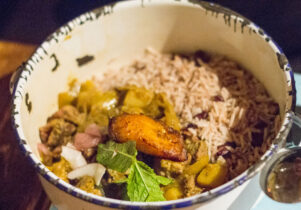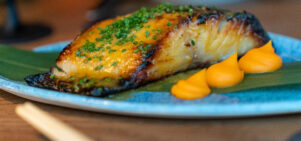Flok
Creative TouristVisit now
Flok
- Monday11:00am - 12:00am
- Tuesday11:00am - 12:00am
- Wednesday11:00am - 12:00am
- Thursday11:00am - 12:00am
- Friday11:00am - 12:00am
- Saturday11:00am - 2:00am
- Sunday11:00am - 2:00am
Always double check opening hours with the venue before making a special visit.

We were gathered in the basement room of Flok, Manchester‘s only sherry specialist bar, to receive instruction from someone who has perhaps one of the best jobs in the world – a Sherry Educator. Fortunately, this event included a practical element, with modest amounts of sherry handed out to us beginners. Of course, we were all very thirsty because it was a hot day.
Sherry is always from Jerez, a region whose especial designation as a food producer is, like Parma and Melton Mowbray, recognised at the highest levels. It is made from the palomino grape and created in cathedral-like structures stacked with barrels which are organised in very particular ways which I must confess were beyond my understanding in that day’s heat.
Perhaps one of the best jobs in the world – a Sherry Educator
I can tell you that it is pumped through special tubes and extracted from the barrel using a Vecenia or Fecenia, a precision tool part way between a stick and a spoon. Traditionally made from bamboo, it is used to get the sherry out without disturbing the yeast. Someone else who probably has the best job in the world makes a show of using the Fecenia at weddings and is called a Fecenador.
We also discovered the etymology of ‘tapas’, from the verb tapar, to cover. At some point in the distant past, it was discovered that you could keep flies and dust out of sherry by putting a piece of bread, meat or cheese over the glass. As this could also be eaten a tradition developed. This may disappoint readers who had previously believed it had something to do with King Alfonso the Wise, but he remains the author of the Cantigas de Santa Maria if not of tapas.
The first sherry was Tio Pepe Fino, which is ‘straight from the barrel’ and ‘En rama’ meaning made in spring, the youngest sherry. It tasted of apples and citrus and had a kind of bready, nutty thing going on as well. The fresh, sweetish flavour makes it good with salty food. Real anchovies were provided.
The next was Amontillado, which is made by exposing the grapes to yeast for only a short time. A minimum of 5 to 7 years old, it works well with artichokes and risotto, and other things that have a smoky, roasted flavour.
We then moved on to the Oloroso, made without yeast and tasting quite like caramel. It is the natural accompaniment to steak and other rich meats, Iberico ham, and game stews. Which was appropriate, because by this time everyone in the basement was a game stew.
You read that right: this sherry is almost as sugary as me
Vinos Dulces Naturales followed, whose grapes are almost raisins when they go in. Leaving them out to dry concentrates the sugars and flavours. Someone said something about Muscat of Alexandria which is very old. Mira la Mar Moscatel was mentioned at around this point and there was some very nice blue cheese. For the non-expert, the takeaway point here is that the brown, sugary type of sherry goes with the blue cheese very well.
We finished with some Pedro Ximenez (PX) which can be centuries old and was at such an extreme of sweetness that it came out like treacle. We put it on ice cream and the sherry was actually the sweeter of the two tastes, with its 500 grams of sugar per litre. You read that right: this sherry is almost as sugary as me.
‘Go to the fortified wine section of any supermarket’, suggested the Educator. ‘It’s criminally cheap’.
Following this advice, I donned a black mask and have been raiding the supermarket wine section ever since. In particular, a dry sherry also makes a great cooking ingredient, due to the way it absorbs and reduces whatever you’ve put in a pan and gives an extra kick to prawns, mushrooms et cetera. Any sherry, even own-brand, will be from Jerez and be of a certain level of quality, but readers wanting sherry at home for whom it is pay day should consider going to Lunya, the Catalan deli on Deansgate, where helpful staff will offer you many special sherries. Readers wanting sherry when out and about should visit Flok where equally helpful staff will tell you everything you need to know.


































